Text
The class stood still as if deer in headlights. Without the direction of their captain, how would order be restored. How would the battle be won. The students heard rumors of a mysterious new instructor who went by the name of Michael. He however, was nowhere to be seen. Messenger pigeons arrived after a few nights in the tundra. Letters withheld dreadful news. The heroic Michael was battling Typhus. All hope was lost. Many a week had past with little headway. drawings were not level, didactic panels were not uniformly located, wires went bare. But... on a cold April night, a shadowed figure emerged over the hillside. It was Michael!!!! Cheers rang through the halls. A parade commenced immediately. The tubas were blaring heart felt tunes, the floats majestically wove past joyous fans. Order had been restored. The Show removed its ugly mask and a phoenix rose from the ashes. Bravo Michael, for your valiant battle with typhus and your astounding leadership. All hope was restored.
0 notes
Link
With our new found admiration for the glorious technology our forefathers entitled “magnets”, here is a brief but tear inducing history. We applaud you magnets for your sleek, pointyless design.
Dear magnets,
you will forever hold a place in my heart
with love,
Mike
0 notes
Text
The Events of 04/12/2018
To express the shear intensity of emotion and grandness of the events of this class period is simply not possible but I shall try my best to embody that magnificent eve into story.
*All quotes have been mildly paraphrased to recreate the overwhelming excitement which was palpable in that narrow corridor.
It all began in the late hours of the afternoon on the 12th day in the month of April of the year 2018. At the start of class, we were all sitting around trying to figure out what to do, awaiting the arrival of the one they call “Michael”. The citizens of the class began to wonder the room searching for clues, a sign of direction. After we used our eyeballs to look at the whiteboard we concluded that we ought to begin to install our work. This conclusion being based on the shapes drawn on the whiteboard which we, thanks to previous knowledge, understood to be direct instructions to do so. This glorious movement to install was abruptly stunted due to an insufficient quantity of magnets to defy the gravity enacting on our pieces of paper which we desperately needed to stay on the wall. Thus, began the quest for magnetism. Shortly after this epic and monumental quest began we all gave up. The solution being to impale our masterpieces onto the wall with pointy metal things. But just as the razor-sharp tip of one of said pointy metal things was about to pierce my Mona Lisa of a drawing, forever leaving a tiny circular hole in the priceless paper on which this masterpiece was created, a messenger from our homeland, being the classroom, came bursting into my periphery.
“Hark! We have found the tiny little metal disks which defy gravity and will save our artwork from a grizzly display of pointy metal things sticking gruesomely into our work!” the heroic messenger exclaimed.
The works were installed with great enthusiasm and anticipation. The citizens marveled at the incredible skills of their fellow peers. Many songs were sung, and stories of this day will surely be passed down generation to generation to the end of time.
0 notes
Link
Great way to Get your students artwork into the world is to have an exhibition somewhere that isn’t the school. It is important to think about how the students’ work are displayed. Think about where the artwork is hung. Anything in a school will ALWAYS feel like student work no matter how impressive. Treat their work as though it is professional. This will bring more attention but also will be a good example to the students on how to display their work in the future, not just in a school hallway. If you treat them professionally they will begin to see themselves as artists that can do this in a more serious manor and may help motivate them to put more thought and energy into their work. The lessons on display from our class are creative and innovative and the work which comes from it should be treated in a way that enhances the creativity and importance of the work being produced.
0 notes
Text
Class on 4/5!!
Blog Post for April 5th by Maddie Wilk
At the beginning of class, Professor Jackson explained a few good techniques to use for project evaluation. She used her Folk Art Chairs lesson plan as an example. She explained that the evaluations cannot be subjective, they have to solidly explain what you as the teacher expect out of your students. This is crucial for the students success because it gives them a clear idea of what they need to be doing.
Next, individual students began teaching the class their lesson plans. I found this to be very enjoyable. It was clear that everyone who went this day was well prepared and worked hard on their creative lesson plans. One of my favorite lessons was taught by Tess, in which we looked at the work of Helen Frankenthaler and then abstracted nature photography in a style similar to hers. Overall, all of the lessons I participated in were creative, engaging and gave me some ideas for my own lesson plan.
I was having trouble when I first started writing my own lesson plan because I wasn’t familiar with the format and al of the detail that is required to go into it. I’ve revised it about 3 times by now, adding some things and taking others out. The more I work with it, the more comfortable I get. I’m really looking forward to teaching the class myself.
A few of the people presenting seemed a little bit nervous, but that is completely understandable. It’s intimidating to stand up in front of your peers and teach them a lesson meant for third graders. It can feel a bit silly. You just have to remember that the entire class is supportive and wants you to teach your best lesson, so there’s no need to be nervous. I think teaching in front of people your own age is really good practice for being an art teacher because after standing in front of a college class, a class full of little kids doesn’t seem so bad. Some other advice I can offer is if you’re using some sort of technology during your lesson, make sure it’s up and working before you begin so you don’t have to pause and figure that mess out in the middle of teaching.
https://www.theartofed.com/lesson-plans/
This link goes to a website filled with creative and unique lesson plans. You’re able to search by both grade level and media. I found this website very useful when brainstorming ideas for my own lesson plan. it also helped me while writing my lesson because I could refer to one of these to further understand the format. I also think this will be a great tool once we’re actually out teaching.
https://www.philamuseum.org/teacherresources?lppID=&lpsID=2
This link goes to the Teacher Resources offered by the Philadelphia Museum of Art. They have a ton of great ideas for lessons focused on art history and the ability to analyze artwork. All of these lessons are on the subject of art, but involve a lot of math or language arts skills as well.









0 notes
Text
Museum Scavenger Hunt Blog
Victoria Fulton
I went to the Philadelphia Museum of Art on a Thursday during the day. It was really a interesting and perfect time for what I was looking for. There was around five groups from different schools that were there. Students ranging from what looked like preschool up to high school age students and a class with students with disabilities. They all had the portable folding chairs, provided by the museum, that they brought along with them. At some artworks they would stop and the teachers would talk about the work for a period of time. It was exciting to see them run around and react to the artwork. The one exhibit which presented clowns on a television (which I personally thought was disturbing), the 5th graders immediately all started laughing.
Visiting museums is so crucial because physical artwork was not created to be viewed on a tiny screen. Students are missing out on the effect of what the artworks original intention if not experienced in real life. I think this comes to play especially when artwork is of a large scale. There is also the excitement surrounding “field trips”. I remember as a kid the anticipation of a field trip was so intense and special. Students are more eager to learn when the environment is different from their usual classroom. It is a really beautiful and opportune time for teachers to take advantage of this peaked interest and capitalize on as much learning as possible.
I think a good strategy is to make the museum interactive and scavenger hunts are a great way to do that. I really enjoyed the personal aspect of the one we had to do. I think it is easier for someone to find interest in artwork that seems distant when they can relate it back to themselves.
In the front of the museum there was younger children with their parents sitting at tables coloring and I noticed tourists scattered. The museums has many events geared towards all different ages.
When I was younger we did not go to any art museums but we did go to other places geared towards science or history. I think the most memorable experiences were the immersive ones. Videos, scenes, or the physical space that transports the viewer to a different space. In regards to the PMA I think the rooms that recreate the physical rooms could be the most interesting for kids. Especially the asian recreation of the courtyard is ones of my personal favorites. The ceiling even feels like the viewer is outside looking up at the sky. It also gives the art within the space more unity and context.
Here are some articles discussing the importance of museum education:
https://www.arteducators.org/news/articles/196-how-do-visits-to-art-museums-impact-k-12-students
https://www.edweek.org/ew/articles/2014/12/03/13greene.h34.html
https://www.nytimes.com/2013/11/24/opinion/sunday/art-makes-you-smart.html












0 notes
Text
Class March 29th
By Annemarie and Leigh
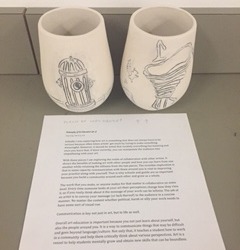

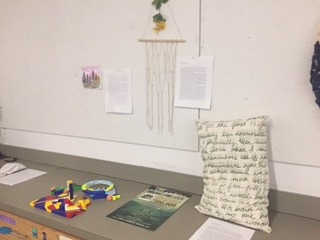



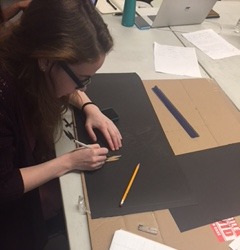
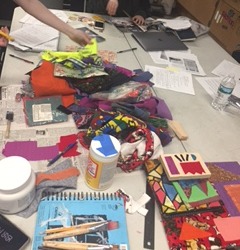
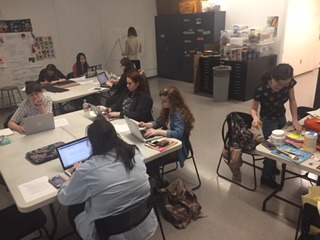

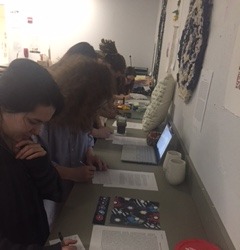
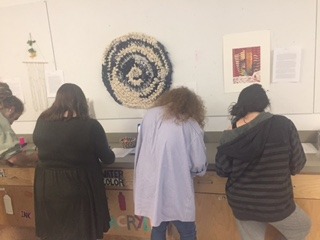
Blog Post Day Covered 3/29; Due 4/5
Today, the Philosophy of Art Education Part III was due. Students displayed their Part III artworks on the counter and wall of the classroom. Later on in the class period, each student critiqued another student's final artwork by writing their opinion on a 3 x 5 card. Who would be critiquing who was chosen at random.
At the beginning of class we watched a trailer for the movie “Geek Girl”. The Art Education Department is showing this film on Tuesday April 3 at 6PM. This film seems like it connects to this courses assigned reading “Why Our Daughters Should Play More Videogames” by Samantha Parent which discussed the importance of getting women involved in the computer science industry. This movie also seems like it connects to some of themes we’ve touched on in class such as videogames as visual culture and how videogames are considered works of art. “Geek Girl” focuses on alternative culture such as cosplay and fandom. They point out the fact how these outlets are used to express identity. It also points out how geek culture is mostly male dominated, particularly in the realm of video games. Female “gamers” are always looked at as inferior by the gaming communities. The film trailer also touches on the effects of cyberbullying on geeks, “geek girls” being prime targets.
The classroom environment was noticeably different today because the table arrangement was a small group arrangement as opposed to our normal U-shaped arrangement. I think that the U shaped table arrangement normally facilitates our classwide discussions/ activities. However, today students spent a majority of time working independently on their own individual lesson plans. The desks had more of a small group arrangement to facilitate lesson plan feedback in small groups and one on one feedback with the professor. Small groups of students, or pods tend to work best for group activities, explorative learning and experimental learning, subjects we have touched on in previous classes. We have spent time thinking about the arrangement of our classrooms and how they can affect the classroom dynamics. We predict that this setup will be less effective for larger group discussion but more effective for small group projects.
The museum photographic scavenger hunt project was also due today. We spent time toward the end of the class period looking at everyone’s photos from the scavenger hunt. I think the photographs that got the greatest responses out of the class were the ones with captions added, because they were funny and the use of humour was engaging.
The lesson plan idea I (Leighann) came up with for the museum photographic scavenger hunt assignment is “Meme-ing at the Art Museum”. The premise of the lesson is: Students will be making their own memes (a total of five memes) by taking photographs of artworks that interest them and adding funny captions to them. The captions will be added through either snapchat or a Meme Generator (https://imgflip.com/memegenerator). An optional element of sharing their memes could be included in this lesson (for example uploading the memes to a social media platform like facebook/instagram/reddit or sending it to classmates through snapchat). At the end of the museum trip, the student with the funniest memes will be the designated “Meme Lord”.
From my own experiences doing other scavenger hunt type activities while on field trips to museums in high school and college, I think teachers often give assignments that are dry, boring, and have a definitive set of right and wrong answers. Instead of enjoying their time at the museum, students end up spending most of the time running around trying to identify and find specific works of art. I think it’s a good idea to create an activity for a museum field trip that’s more engaging and explorative so that students can actually have fun while on the trip.
In the wake of us developing our lesson plans I thought it’d be helpful to post some resources that might help with lesson plan idea development:
https://www.deepspacesparkle.com/
Deep Space Sparkle is a site that the host teacher I’m observing recommended for lesson plan ideas. The site has a lot of interesting podcasts and has a variety of art lesson plan ideas which can be filtered by grade level, medium/technique, and subject.
https://www.amazon.com/Art-Lab-Kids-Printmaking-Media/dp/1592537650/ref=sr_1_1?ie=UTF8&qid=1522391300&sr=8-1&keywords=art+lab
Another resource that my host teacher showed me are the Art Lab books - there’s a ton of these books available; Art Lab for Kids, Art Lab for Little Kids, Paint Lab, Collage Lab, Drawing Lab, Print & Stamp Lab, and more. I actually purchased the “Collage Lab” and “Print & Stamp Lab” books and I think there’s a lot of cool project ideas, techniques, and visuals that could help spark ideas for lessons. I’ve noticed that a lot of the projects in these two books utilize cheap, recycled, found materials and upcycled/unconventional tools.
For my lesson plan (Annemarie) I am doing a long term project with grades 10-12 about the surrealist movement, which I will call “Are you Surreal? The idea behind the lesson is that student will be selecting unrelated images from magazines which they will then collage. This collage will be a reference for a full color surrealist painting. I aim to have students understand how surrealists took seemingly random images and juxtaposed them in one piece to create an alternative reality, many times resembling a dreamlike state. I want them see how when looking at these unusual images our brain starts making connections between the subject matter. They will be learning technical skills such as underpainting and collage as well as the history and concept behind the surrealism movement which I believe to be an underappreciated art form.
My experience with the scavenger hunt was interesting, much different than an unguided walk through the museum. Having grown up in philly in an art loving family I have been to the Philadelphia Museum of Art countless times. I have the location of every room memorized, I know where my favorite pieces are and recognize most of the permanent collection. Having specific prompts forced me to search through a museum I thought I knew in and out. I walked through slower, taking note of not only the pieces I like, but the ones I didn't like too. The scavenger hunt item I had the hardest time with was finding a piece that reflects my own personal work. A Lot of pieces reflected parts of my personal work, some in design some in material. I finally decided on a case full of old carving tools because overall I love the process of working in a craft medium like metal better than any end product.
Since we were discussing the set up of classrooms here are a few links which I think will be helpful.
https://www.teachingchannel.org/videos/seating-arrangements
Teaching Channel is a forum for teachers to post and discuss issues and strategies in the classroom. This site has videos and articles in all common school subjects as well as a Q and A where you can search common questions or post your own for responses from other teachers.
The link above talks about seating arrangements and workstations.
https://teach4theheart.com/podcast/
Teach 4 the heart is a great podcast which discusses strategies for minimizing problems in the classroom. Subjects include methods to calm a disruptive class, how to counsel a student and how to create classroom shakeup and more.
0 notes
Text
Museum Scavenger Hunt
Kieun Song
1.

2.


3.


4.

5.

6.


0 notes
Text







“When you’re dead inside but your friends make you go out”
0 notes
Photo







Your parents tell you to take the chicken out while they’re at work but by the time they get home the chickens still in the freezer.
When you forget to take the chicken out...
0 notes
Text
Museum Trip Blog Post
Julia Sallamack:

Summary:
On Sunday morning I went to the Philadelphia Museum of Art. It was only my second time going there and I was most excited to see the Modern and Contemporary wing that I missed last time. I was nervous about having enough time to complete both the scavenger hunt and the blog post, but I had more than enough time to gather material for both assignments and spend time wandering around the museum. Most other times that I have gone to museums for class assignments, the assignment takes up too much time to have unstructured museum time as well, so I really was glad that this assignment was short and pretty open ended. I think that this is probably the best model for a museum scavenger hunt so I think that if I ever assign one it will be similar to this.
I based my lesson plan on the museum trips I took with my Dad when I was little. I loved going to the museum with my Dad because I was able to tell him which parts of the museum I wanted to see and we would spend a lot of time looking independently, and also talking about art together. I think I was able to engage with the work more because I got to choose most of what we would look at. My Dad encouraged me to share my opinions, which made me feel like my thoughts were valued, but he would also argue with me so I had to backup my opinions with evidence. I think that because of this I learned how to engage with works of art for longer periods of time, was able to practice talking about art, and able to practice communicating my ideas with evidence.
Unfortunately, it isn’t really practical to have long, individualized discussions with each and every student on a class trip so I wrote a sketchbook assignment. The assignment is to write/sketch while looking at works of art, either individually or with partners. They will choose 3 pieces from the museum and write/sketch in front of the first one for 1 minute, then in front of the second for 5 minutes, then in front of the third for 7 minutes. They will write the title of the work they chose, the artist’s name, the year it was made, and how long they wrote/drew for above their response to the work. If they chose to work with others then they have to pass the paper back and forth and respond to each other’s writing/sketching about the work. They also have to multiply the timing by the number of people in their group, for example, 2 people would write for 2 minutes, 10 minutes, then 14 minutes and put all their names on the paper. People who choose to work individually will have more freedom over the artworks that they choose to write about and people who work in groups will be able to respond to another person's opinions about the artworks. I think this assignment would give students some of the benefits that individual discussions in the museum would, especially if it is paired with individualized classroom feedback.
Reflections:
I think that the ideal museum trip is like the ideal classroom situation. It would mostly be self-directed, student-centered learning. I think that the best way to do this would be for students to have the freedom to look at what they want in a museum and have discussions with their peers and individually with their teacher about what they are looking at. I think for this to work the class size would have to be very small or multiple teachers would have to go on the trip. Also the students would have to have prior knowledge of formal qualities of artwork as well as the maturity for self-directed work. I think that implementing the ideal museum trip faces the same challenges as the ideal classroom, with the added challenge of being held in a much larger environment.
I didn’t find out much about the educational programs offered at the PMA, but I found out where the art classrooms are. They are in the basement in an annex, down a long hallway and past some rooms used as lunchrooms and lecture classrooms. The art rooms were small and packed with art supplies. I was really excited to see that they have a printing press.








Links:
https://www.gse.harvard.edu/news/uk/16/12/more-meaningful-field-trip
This article from Harvard Graduate School of Education talks about how to make museum trips more meaningful for students and some of the barriers between teachers and museums.
https://www.reddit.com/r/Teachers/
https://www.reddit.com/r/ArtEd/
I have been looking at these two subreddits recently. Reddit is a website where people can make message boards based on interest and vote on content. These two boards are mostly teachers sharing their experiences and asking for advice. I like that because it is anonymous you get to read some unfiltered opinions about teaching, but it tends to be posts from people who are either loving or hating their jobs at the moment. Overall you have to take everything written there with a grain of salt, but it’s nice to be able to see how some teachers feel about a topic or to find out more about teaching in certain areas from anonymous teachers.
0 notes













































